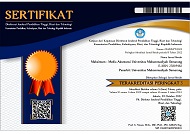Does The Psychology of Investment Decisions Depend on Risk Perception And Financial Literacy?
(1) STIE YKPN Yogyakarta,
(2) STIE YKPN Yogyakarta,
(*) Corresponding Author
Abstract
This study examines and analyses the effect of overconfidence, herding effect, and disposition effect bias on investment decisions mediated by risk perception and moderated by financial literacy. The sample for this study uses 184 investors from 19 provinces in Indonesia using a purposive sampling technique. Regression partial least squares test the hypothesis with the Warp-PLS application version. The study's results found that overconfidence bias does not affect risk perception. Herding effect bias and disposition bias have positive effects on risk perception. Risk perception has a positive effect on investment decisions. Risk perception fully mediates the relationship between disposition effect bias on investment decisions. However, risk perception does not mediate the relationship between overconfidence bias and herding effect bias on investment decisions. Meanwhile, financial literacy must moderate the relationship between risk perception and investment decisions. The implication of the study is expected to assist the Financial Services Authority in increasing investors' financial literacy in the capital market.
Keywords
Full Text:
PDFReferences
Ademola, S. A., Musa, A. S., & Innocent, I. O. (2019). Moderating Effect of Risk Perception on Financial Knowledge, Literacy and Investment Decision. American International Journal of Economics and Finance Research, 1(1), 34–44. https://doi.org/10.46545/aijefr.v1i1.60
Adil, M., Singh, Y., & Ansari, M. S. (2022). How financial literacy moderate the association between behaviour biases and investment decision? Asian Journal of Accounting Research, 7(1), 17–30. https://doi.org/10.1108/AJAR-09-2020-0086
Ahmad, M., & Shah, S. Z. A. (2020). Overconfidence heuristic-driven bias in investment decision-making and performance: mediating effects of risk perception and moderating effects of financial literacy. Journal of Economic and Administrative Sciences, 38(1), 60–90. https://doi.org/10.1108/jeas-07-2020-0116
Ahmed, Z., Rasool, S., Saleem, Q., Khan, M. A., & Kanwal, S. (2022). Mediating Role of Risk Perception Between Behavioral Biases and Investor’s Investment Decisions. SAGE Open, 12(2), 215824402210973. https://doi.org/10.1177/21582440221097394
Alquraan, T., Alqisie, A., & Al Shorafa, A. (2016). Do Behavioral Finance Factors Influence Stock Investment Decisions of Individual Investors? (Evidences from Saudi Stock Market). American International Journal of Contemporary Research, 6(3), 159–169.
Arifin, Z., & Soleha, E. (2019). Overconfidence , Attitude Toward Risk , and Financial Literacy : A Case in Indonesia Stock Exchange. Review of Integrative Business and Economics Research, 8(4), 6722.
Arrow, K. (1971). Essays in the Theory of Risk-Bearing. Markham Publishing Company.
Baddeley, M., Burke, C., Schultz, W., & Tobler, P. (2010). 1 IMPACTS OF PERSONALITY ON HERDING IN FINANCIAL DECISION-MAKING 1 Michelle Baddeley , Chris Burke , Wolfram Schultz and Philippe Tobler. January, 1–35.
Busenitz, L. W., & Barney, J. B. (1997). Differences between entrepreneurs and managers in large organizations: Biases and heuristics in strategic decision-making. Journal of Business Venturing, 12(1), 9–30. https://doi.org/10.1016/S0883-9026(96)00003-1
Butt, M., Jamil, N., & Nawaz, R. (2015a). The Mediating Role of Risk Perception among Cognitive Biases towards Decision to Start a New Venture. International Letters of Social and Humanistic Sciences, 54(2012), 88–95. https://doi.org/10.18052/www.scipress.com/ilshs.54.88
Butt, M., Jamil, N., & Nawaz, R. (2015b). The Mediating Role of Risk Perception among Cognitive Biases towards Decision to Start a New Venture. International Letters of Social and Humanistic Sciences, 54(6), 88–95. https://doi.org/10.18052/www.scipress.com/ilshs.54.88
Combrink, S., & Lew, C. (2020). Potential Underdog Bias, Overconfidence and Risk Propensity in Investor Decision-Making Behavior. Journal of Behavioral Finance, 21(4), 337–351. https://doi.org/10.1080/15427560.2019.1692843
Daniel, K., & Hirshleifer, D. (2015). Overconfident investors, predictable returns, and excessive trading. Journal of Economic Perspectives, 29(4), 61–88. https://doi.org/10.1257/jep.29.4.61
Dar, N. I., Shah, S. Z. A., & Ahmed, Z. (2021). Behavioral Cost of Managerial Decisions Under Risk Perception and Culture: A Comparative Study Between the United States and Pakistan. SAGE Open, 11(3). https://doi.org/10.1177/21582440211027896
Forlani, D., & Mullins, J. W. (2000). Perceived risks and choices in entrepreneurs’ new venture decisions. Journal of Business Venturing, 15(4), 305–322. https://doi.org/10.1016/S0883-9026(98)00017-2
Genesove, D., & Mayer, C. (2001). LOSS AVERSION AND SELLER BEHAVIOR : EVIDENCE FROM THE HOUSING MARKET * Housing markets exhibit a number of puzzling features , in- cluding a strong positive correlation between prices and sales volume and a negative correlation between prices and time on. November.
Hartanto, M. C., Prajanto, A., & Nurcahyono, N. (2023). Determinants of going-concern audit opinions : Empirical evidence from listed mining firms in Indonesia. Maksimum: Media Akuntansi Universitas Muhammadiyah Semarang, 13(1), 17–27. https://doi.org/10.26714/mki.13.1.2023.17-27
Hussain, M., & Ali, K. M. (2014). An Empirical Investigation on Behavioral Determinants of Perceived Investment Performance; Evidence from Karachi Stock Exchange. Research Journal of Finance and Accounting, 5(21), 2222–2847.
Huston, S. J. (2010). Measuring Financial Literacy. Journal of Consumer Affairs, 44(2), 296–316. https://doi.org/10.1111/j.1745-6606.2010.01170.x
Ishfaq, M., Maqbool, Z., Akram, S., Tariq, S., & Khurshid, M. . (2017). Mediating Role of Risk Perception between Cognitive Biases and Risky Investment Decision : Empirical Evidence from Pakistan ’ s Equity Market. Journal of Managerial Sciences, 11(03), 266–278.
Kahneman, D., & Lovallo, D. (1993). Timid choices and bold forecasts: A cognitive perspective on risk taking. Choices, Values, and Frames, 39(1), 393–413. https://doi.org/10.1017/CBO9780511803475.023
Kartika, N., & Iramani, R. (2013). Pengaruh Overconfidence, Experience, Emotion Terhadap Risk Perception Dan Risk Attitude Pada Investor Pasar Modal Di Surabaya. Journal of Business and Banking, 3(2), 177. https://doi.org/10.14414/jbb.v3i2.235
Khatik, N., & Fatmasari Sukesti, I. K. (2022). Financial Performance before and during the Covid-19 Pandemic on Islamic Microfinance Institutions (Case Study Btm Kaliwungu).
Kengatharan, L., & Kengatharan, N. (2014). The Influence of Behavioral Factors in Making Investment Decisions and Performance: Study on Investors of Colombo Stock Exchange, Sri Lanka. Asian Journal of Finance & Accounting, 6(1), 1. https://doi.org/10.5296/ajfa.v6i1.4893
Khan, M. T. I., Siow-Hooi, T., & Lee-Lee, C. (2016). The Effects of Stated Preferences for Firm Characteristics, Optimism and Overconfidence on Trading Activities. International Journal of Bank Marketing, 34(7), 1–25.
Kim, H., Batten, J. A., & Ryu, D. (2020). Financial crisis, bank diversification, and financial stability: OECD countries. International Review of Economics and Finance, 65(January 2019), 94–104. https://doi.org/10.1016/j.iref.2019.08.009
Kristiana, I., & Nurkatik, N. (2021). The Effect of SAK EMKM-Based Accounting Implementation, Accounting Knowledge, Education Level, and Revenue on MSME Taxpayer Compliance in Reporting its Tax Obligations during the COVID-19 Pandemic. Universal Journal of Accounting and Finance, 9(6), 1422-1432.
Kumar, S., & Goyal, N. (2015). Behavioural biases in investment decision making – a systematic literature review. Qualitative Research in Financial Markets, 7(1), 88–108. https://doi.org/10.1108/QRFM-07-2014-0022
Kustodian Sentral Efek Indonesia. (2022). Statistik Pasar Modal Indonesia Juni 2022. Kustodian Sentral Efek Indonesia, April, 1–6.
Listyani, T. T., Rois, M., & Prihati, S. (2019). Analisis Pengaruh Pengetahuan Investasi, Pelatihan Pasar Modal, Modal Investasi Minimal Dan Persepsi Risiko Terhadap Minat Investasi Mahasiswa Di Pasar Modal (Studi Pada Pt Phintraco Sekuritas Branch Office Semarang). Jurnal Aktual Akuntansi Keuangan Bisnis Terapan (AKUNBISNIS), 2(1), 49. https://doi.org/10.32497/akunbisnis.v2i1.1524
Malhotra, N. (2014). Basic Marketing Research. Pearson Education.
Mallik, K. A., Munir, M. A., & Sarwar, S. (2017). Impact Of Overconfidence And Loss Aversion Biases On Investor Decision Making Behavior: Mediating Role Of Risk Perception. International Journal of Public Finance, Law & Taxation, 1(1), 13–24.
Nareswari, N., Bramanti, G. W., & Kunaifi, A. (2022). The Effect of Behavioral Biases on Risk Perception. Proceedings of the 3rd International Conference on Business and Management of Technology (ICONBMT 2021), 202(Iconbmt), 95–99. https://doi.org/10.2991/aebmr.k.211226.013
Nurcahyono, N., Hanum, A. N., Kristiana, I., & Pamungkas, I. D. (2021). Predicting fraudulent financial statement risk: The testing dechow f-score financial sector company inindonesia. Universal Journal of Accounting and Finance, 9(6), 1487-1494.
Nur Aini, N. S., & Lutfi, L. (2019). The influence of risk perception, risk tolerance, overconfidence, and loss aversion towards investment decision making. Journal of Economics, Business & Accountancy Ventura, 21(3), 401. https://doi.org/10.14414/jebav.v21i3.1663
Pelster, M., & Hofmann, A. (2018). About the fear of reputational loss: Social trading and the disposition effect. Journal of Banking and Finance, 94, 75–88. https://doi.org/10.1016/j.jbankfin.2018.07.003
Pompian, M. M. (2011). Behavioral finance and wealth management: How to build investment strategies that account for investor biases. In Behavioral Finance and Wealth Management: How to Build Investment Strategies That Account for Investor Biases. https://doi.org/10.1002/9781119202400
Rahma, A. M., Nurcahyono, N., & Sinarasri, A. (2022). Moderating Effects of Institutional Ownership on the Relation Between Capital Structure. International Conference on Business, Accounting, Banking, and Economics, 1, 293–306. https://doi.org/10.2991/978-94-6463-154-8
Rashid, A., Fayyaz, M., & Karim, M. (2019). Investor sentiment, momentum, and stock returns: an examination for direct and indirect effects. Economic Research-Ekonomska Istrazivanja , 32(1), 2638–2656. https://doi.org/10.1080/1331677X.2019.1650652
Ritter, J. R. (2003). Behavioral finance. Pacific Basin Finance Journal, 11(4), 429–437. https://doi.org/10.1016/S0927-538X(03)00048-9
Rooij, V. M., Lusardi, A., & Alessie, R. (2011). Financial literacy and stock market participation. Journal of Financial Economics, 101(2), 449–472. https://doi.org/10.1016/j.jfineco.2011.03.006
Sindhu, & Kumar, D. S. R. (2014). Influence of Risk Perception of Investors on Investment Decisions: An Empirical Analysis. 2(2), 15–25.
Singh, S. (2016). The Role of Behavioral Finance in Risk Management. Risk Management: A Modern Perspective, June, 653–676. https://doi.org/10.1016/B978-012088438-4.50029-0
Tandio, T., & Widanaputra, A. A. G. P. (2016). E-Jurnal Akuntansi Universitas Udayana PENGARUH PELATIHAN PASAR MODAL , RETURN , PERSEPSI RISIKO , GENDER , DAN KEMAJUAN TEKNOLOGI PADA MINAT Fakultas Ekonomi dan Bisnis Universitas Udayana ( Unud ), Bali , Indonesia Fakultas Ekonomi dan Bisnis Universita. 16, 2316–2341.
Ullah, S. (2015). An Empirical Study of Illusion of Control and Self-Serving Attribution Bias, Impact on Investor’s Decision Making: Moderating Role of Financial Literacy. Research Journal of Finance and Accounting Www.Iiste.Org ISSN, 6(19), 109–118.
Yaowen, X., Suqing, S., Pengzhu, Z., & Tian, M. (2015). Impact of Cognitive Bias on Improvised Decision-Makers’ Risk Behavior: An Analysis Based on the Mediating Effect of Expected Revenue and Risk Perception. Management Science and Engineering, 9(2), 31–42. https://doi.org/10.3968/6843
Article Metrics
Abstract view : 576 timesPDF - 10 times
DOI: https://doi.org/10.26714/mki.13.2.2023.152-163
Refbacks
- There are currently no refbacks.
-----------------------------------------------------------------------------------------------------------------------------------------------------------------------------------
 | MAKSIMUM: Media Akuntansi Universitas Muhammadiyah Semarang |
![]()
Maksimum: Media Akuntansi Universitas Muhammadiyah Semarang is licensed under a Creative Commons Attribution Attribution-NonCommercial-NoDerivatives 4.0 International License.

















